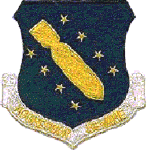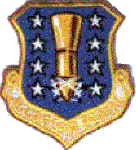 |
44th
Bombardment Wing
Motto:
"Aggressor Beware"
Patch at
left
44th Strategic Missile Wing
Patch at
right |
 |
|
Based at: Chennault
AFB, Ellsworth AFB
Aircraft: B-29, B-47, Titan Missiles, Minuteman Missiles
Status: Unknown
Squadrons: 66BS, 67 BS, 68 BS, 506 BS, 66 MS, 67 MS, 68 MS, 850 MS,
44 AR
Links: Black Hills Bandit -
online newspaper |
|
Initial SAC Bomb Group
The
44th Bombardment Group was one of the ten bombardment groups assigned to SAC when it was first formed March 21,
1946. The group flew B-24s in Europe during World War II. It
was inactivated on July 12, 1946. Of the ten original groups, all
but the 93rd and the 509th were inactivated in 1946.
(See
Original Bomb Groups).
Activation
Reactivated and assigned to SAC
on July 1, 1947, but was not manned. Reactivated again on Sept. 6,
1948.Established as the 44th Bombardment Wing,
Medium, on December 20, 1950. Activated January 2, 1951 at March
AFB. Moved to Lake Charles (later Chennault) AFB on August 1,
1951.
Korean War
The 44th was a child of the Korean War.
It was activated when the war was six months old. It depended on
the 22nd Bomb Wing for it's initial cadre and help in becoming
organized. From October 1, 1951 to August 29, 1952, it
served as the operation training unit for B-29 aircrews and maintenance
personnel for Far East Air Forces. It also trained all
elements of the 68th Strategic Reconnaissance Wing. from October
10, 1951 to May 15, 1952. During this time, it flew B-29s and
TB-29s.B-47s and KC-97s
The wing received B-47s and KC-97 tankers in
1953 and became a first line bombardment wing. It was deployed to
Sidi Slimane AB, French Morocco January 19 to - Feb. 1952 and from April
19 to June 17, 1954. Discontinued in 1960, when it's planes were
phased out.
Missile Mission
Organized in 1962 as a strategic missile
wing at Ellsworth AFB; Rapid City South Dakota. It was initially
assigned a Titan missile squadron, but later phased it out and took over
operational control of three Minuteman missile squadrons.
Status
Unknown
Components
Group
44th Group: Jan 2, 1951-June 16, 1952 (Not operational Feb 10, 1951-June
16, 1952)
Squadrons:
66th BS: Attached Feb. 10, 1951-June 15-1952 (not operational Feb
10-Mach 5, 1951)
Assigned June 16,
1952-June 15, 1960.
67th BS: Attached Feb. 10, 1951 - June 15, 1952 (not operation
Feb. 10-22, 1951)
Assigned June
16-1952-June 15, 1960.
68th BS: Attached Feb. 10, 1951-June 15, 1952 (not
operational Feb. 10-March 27, 1951);
Assigned June 16,1952-June
15, 1960
506 BS: Dec. 1, 1958 - June 15, 1960
66th MS: Assigned July 1, 1962 - (not operational Jul
1, 1956-Feb. 1963)
67th MS: Assigned Aug 1, 1962- (not operational Aug.
1, 1962-Feb. 1963)
68 MS: Assigned Sept 1, 1952 - (not operational Sept.
2, 192-Feb. 1963)
850th MS Jan 1, 1962-March 25, 1964 (not operational); Feb. 15 -March
25, 1965
44th AR: April 20, 1952- June 1-1060 (not operational April 20-May
15, 1953,
detached June 27, - Oct 11, 1957)
Missile Wing
In October 1960, Ellsworth
AFB entered the "Space Age," with the activation of the 850th Strategic
Missile Squadron, initially assigned to the 28 BMW. Throughout its
history, the 44th Strategic Missile Wing competed strongly in Olympic
Arena competition, frequently claiming top honors at the Vandenberg-hosted
competition.
Titan I
For more than a year this squadron prepared for the
emplacement of Titan I intercontinental ballistic missiles (ICBM), which
finally arrived in 1962, shortly after the activation of the 44th
Strategic Missile Wing (SMW) in January. At that time Headquarters SAC
also named the 44 SMW as host wing at Ellsworth. The wing
received its first operational Titan I missile on 22 June 1962. The Titan
I missile sites were located near Wicksville, Hermosa, and Sturgis SD. The
850th Strategic Missile Squadron controlled maintenance and operations of
the missiles.
Titan's life span was short in western South Dakota. In
July 1962, SAC had effectively rendered it obsolete by activating the 66th
Strategic Missile Squadron, the first of three such units slated to
operate 150 Minuteman I ICBMs under the 44 SMW. The last Titan missile had
been removed in February 1965. Since the Minuteman had completely replaced
the Titan’s, the 850 SMS was inactivated on 25 March 1965
Minuteman I
During 1962, three new strategic missile squadrons - the
66th,67th, and 68th, were activated to support the new Minuteman I system.
The 67th Strategic Missile Squadron joined the 44th in August, followed by
the 68th Strategic Missile Squadron in September 1962. A 44th Missile
Maintenance Squadron was established at the same time. Each strategic
missile squadron supported five flights of Minuteman missiles with 50
missiles per squadron.
A total of 150 launch facilities were constructed to house
the missiles. The first Minuteman missile was positioned near Wall, SD in
April 1963. All Minuteman I missiles were in place by the end of 1963. On
1 March 1965, “Operation Long Life” took place. This was the first of
three scheduled launches of the Minuteman system. A missile with seven
seconds of fuel was launched. With the test proving successful, the
additional two launches were canceled. This was the only test launch in US
ICBM history to be fired from an operational site.
Ellsworth was slated to host a unique series of
operational tests. Approved by the Secretary of Defense in November 1964,
“Project Long Life” called for the short-range operational base launch of
three modified Minuteman IB ICBMs to provide a realistic test for this
system. Each missile would contain enough propellant for a 7-second flight
and have inert upper stages and reentry vehicles. The first launch
occurred on March 1, 1965, and successfully demonstrated the ability of a
SAC missile crew to launch an ICBM.
The 44 SMW played a key role in establishing the
Airborne Launch Control System in the late 1960’s. On 1 January 1970, the
44 SMW assumed airborne launch responsibility for Minot Air Force Base,
ND, and Malstrom AFB, MT. Four months later, the ALCS joined the Post
Attack Command and Control System forming the 4th Airborne Command and
Control Squadron, which was assigned to the 28th Bombardment Wing at
Ellsworth AFB, SD.
On 30 June 1971, the 44 SMW was named host unit
at Ellsworth AFB when the 821st Strategic Aerospace Division was
inactivated. The wing was reassigned under the 4th Air Division
headquartered at F.E. Warren AFB, WY. The wing was later assigned as part
of the 57th Air Division headquartered at Minot AFB, ND.
Minuteman II
In October 1971, the transition from Minuteman I to
Minuteman II began. The transition, known as “Force Modernization”, was
complete in March 1973. With these new missiles in place, Ellsworth was
selected to host “Giant Pace Test 74-1,” the first Simulated Electronic
Launch-Minuteman SELM) exercise. During this test, 11 SELM-configured
Minuteman II ICBMs underwent successful simulated launch on command from
both underground launch-control centers and the Airborne Launch Control
System.
During February 1991, the Secretary of Defense announced that
the Air Force would begin retirement of older weapon systems in response
to a changing world environment and declining defense budget. The
deactivation of the Minuteman II missile system was announced on 15 April
1991. The schedule for Ellsworth included a one squadron per year
draw-down beginning with the 67 SMS, followed by the 66 SMS, and finally
the 68 SMS. Under a Strategic Air Command (SAC) wide
reorganization plan, the unit was redesignated the 44th Missile Wing and
assigned to the 20th Air Force.
On 28 September 1991, in response to President Bush’s
directive to stand down the Minuteman II, personnel of the 44 MW worked
around the clock to dissipate launch codes and pin safety control switches
at 15 launch control facilities. Removal of the first Minuteman II missile
assigned to the 44 MW occurred at G-02, near Red Owl, South Dakota, on 3
December 1991. On 6 April 1992, the first launch control center shut down.
On 1 June 1992, the 44 MW was relieved of its emergency war order mission
and its primary focus was deactivation of the Minuteman II weapon system.
This day also marked the end of SAC and the beginning of Air Combat
Command (ACC), which the 44 MW was assigned to. The 67th Missile Squadron
(MS) was inactivated on 15 August 1992, and the 66 MS was inactivated on 1
September 1993. On 1 July 1993 the 44 MW changed hands from ACC to Air
Force Space Command along with all other ICBM wings. Deactivation of the
entire missile complex ended in April 1994. With its mission complete, the
44th Missile Wing formally inactivated on 4 July 1994. |
|
